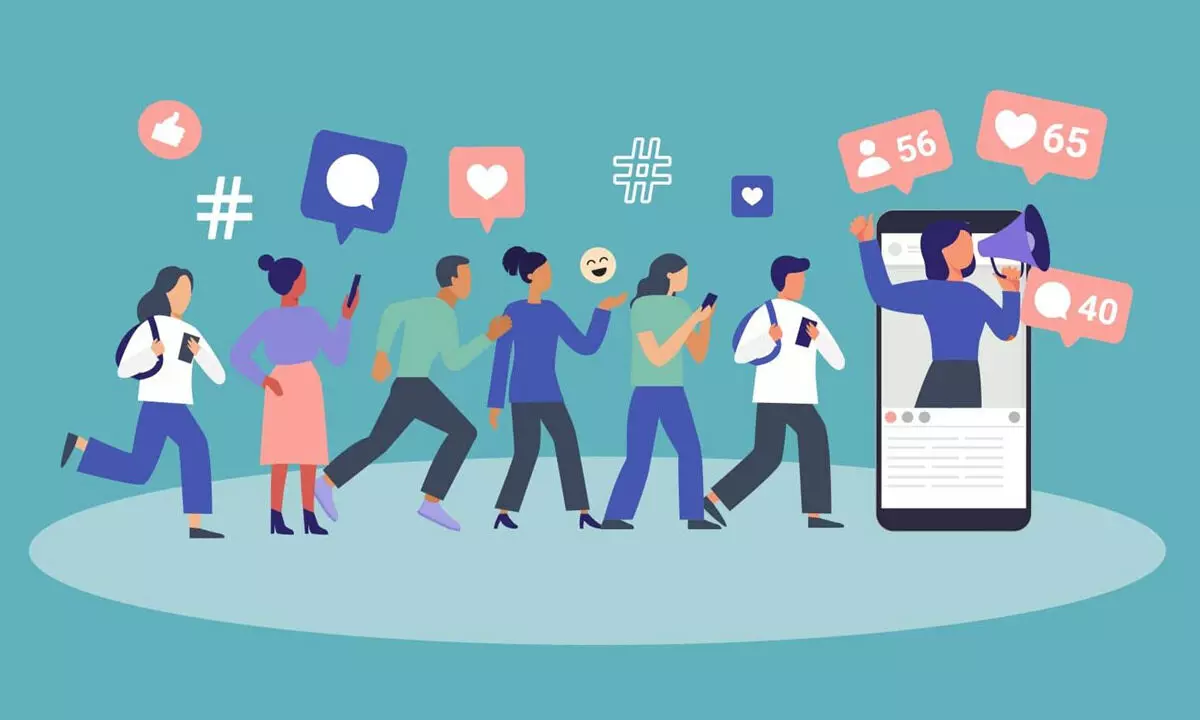Live
- BJP announces Mohan Singh Bisht as Mustafabad candidate for February 5 Delhi polls
- BJP to seek EC probe into source of AAP’s crowd funding
- BJP will give house to all homeless in Delhi: Virendra Sachdeva
- Key India-Nepal meeting discusses ways to combat unauthorised trade
- BJP to seek EC probe into source of AAP’s crowd funding
- Telangana Mourns the Loss of Former MP Manda Jagannadham
- Next-Gen Global Delivery Hub Opens in Hyderabad
- Youth Inspired by Swami Vivekananda: Sindhanoor Village Sets an Example of Community Service
- Swami Vivekananda’s Ideals Inspire Youth: Grand Celebration in Ieeja
- Felicitation Ceremony for Newly Elected BJP Presidents in Aiza
Just In
How influencer marketing gaining traction these days


How influencer marketing gaining traction these days
Micro-influencers shot to prominence because of intimate bonds with their followers
In recent years, influencer marketing has become the hot new strategy for brands looking to expand their reach, increase brand awareness and boost conversions.
The concept of influencer marketing has been around for longer than many of us can recall. Before the dawn of the social media era, people relied on what they saw in print ads, radio and television for product recommendations. But even the earliest marketers figured out that featuring influential people in their ads could swing the purchasing decisions of consumers.
Starting as early as the 18th century, marketers have leveraged the power of influential people. Josiah Wedgwood was a British potter whose cream-colored artwork got the approval of Queen Charlotte in 1765 — even earning him the official title of “Her Majesty’s Potter.” Knowing that the Queen was the ultimate influencer at the time, Wedgwood leveraged his new status and promoted his pottery as “Queensware,” the world’s first luxury brand. The royal endorsement catalyzed his brand, as people started flocking to his business, clamouring for his work soon after.
Influencer marketing has drastically changed the advertising industry and the way that brands interact with their target markets. Influencer marketing’s early stages mostly comprised famous people and public personalities endorsing goods and services. However, the business progressed towards a more genuine and accessible approach as consumer behaviour and preferences changed.
We shall examine the development of influencer marketing in this essay, charting its progression from endorsements to authenticity.
In today’s scenario, influencer marketing includes any arrangement between a company and a well-known social media personality with the goal of using the person’s following to promote the company’s goods. The emergence of social media, which elevated influencers, who weren’t particularly renowned but had a devoted following, was one of the key turning points in the history of influencer marketing. This trend has roots in the early days of advertising, when companies used celebrities’ notoriety and trustworthiness to promote their goods. Celebrities were viewed as role models, and their endorsements were effective persuasion strategies. Customers were swayed by their favourite celebrities, which enhanced brand recognition and sales. This conventional approach, however, has had several drawbacks. It lacked a personal connection with the audience, was frequently pricey, and was only available to prominent personalities. Influencer marketing changed as social media platforms were introduced. A new generation of influencers was created as a result of the popularity of platforms like Instagram, YouTube, and TikTok. These people developed sizable fan bases by producing content that connected with their audience. In contrast to traditional celebrities, these social media influencers were approachable, relevant, and specialised in fields like fashion, beauty, fitness, or gaming.
As social media platforms like Facebook, Instagram, Twitter, and YouTube arose, everyone jumped at the chance to share their everyday life online. Of course, famous people — like celebrities, reality TV stars, and even bloggers — garnered many followers on social media due to their existing popularity. But a new phenomenon quickly set in as a handful of “regular” people started accumulating large followings as well, due to their highly engaging content and close interactions with their followers. Because of their ability to influence the decisions of their audience, these “regular” people became known as influencers. Compared to celebrities and even reality TV stars, influencers are more similar to us. Most of them don’t own giant mansions or fly around on private jets. Instead, they post relatable content about the good, the bad, and the ugly in their lives. Their consistent authenticity has earned them the high level of trust and authority given to them by their followers.
As influencer marketing spread, audiences started to demand honesty and openness from the influencers they followed. They wanted real connections and became weary of excessively promoted messages that lacked authority. Influencers who noticed this trend started integrating authenticity into their brand partnerships. In order to build trust and loyalty among their followers, they started to offer personal experiences, frank reviews, and real experiences with goods or services.
The emergence of micro-influencers was another important development in influencer marketing. These are people who have tiny but very engaged audiences in particular niches. Micro-influencers frequently have a strong love for the subject they choose and form intimate bonds with their followers. As a result of their ability to reach their devoted follower bases with more specialised and focused messaging, brands began to recognise the potential of micro-influencers. Brands were able to connect with a highly engaged audience and spark genuine dialogues about their products by working with micro-influencers.

© 2025 Hyderabad Media House Limited/The Hans India. All rights reserved. Powered by hocalwire.com






